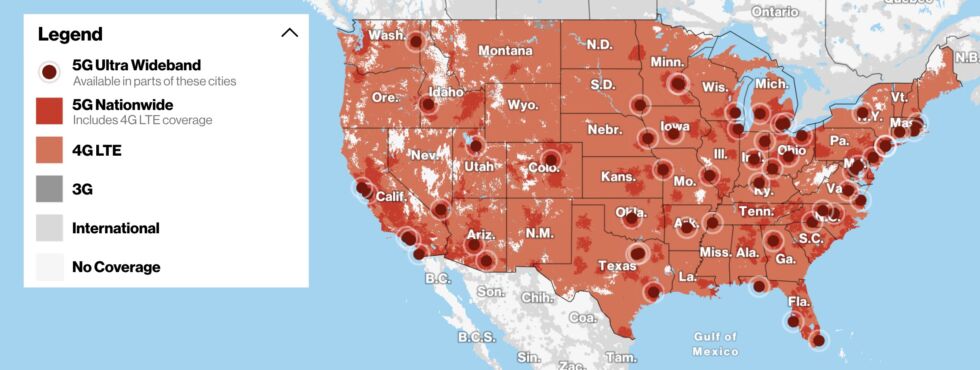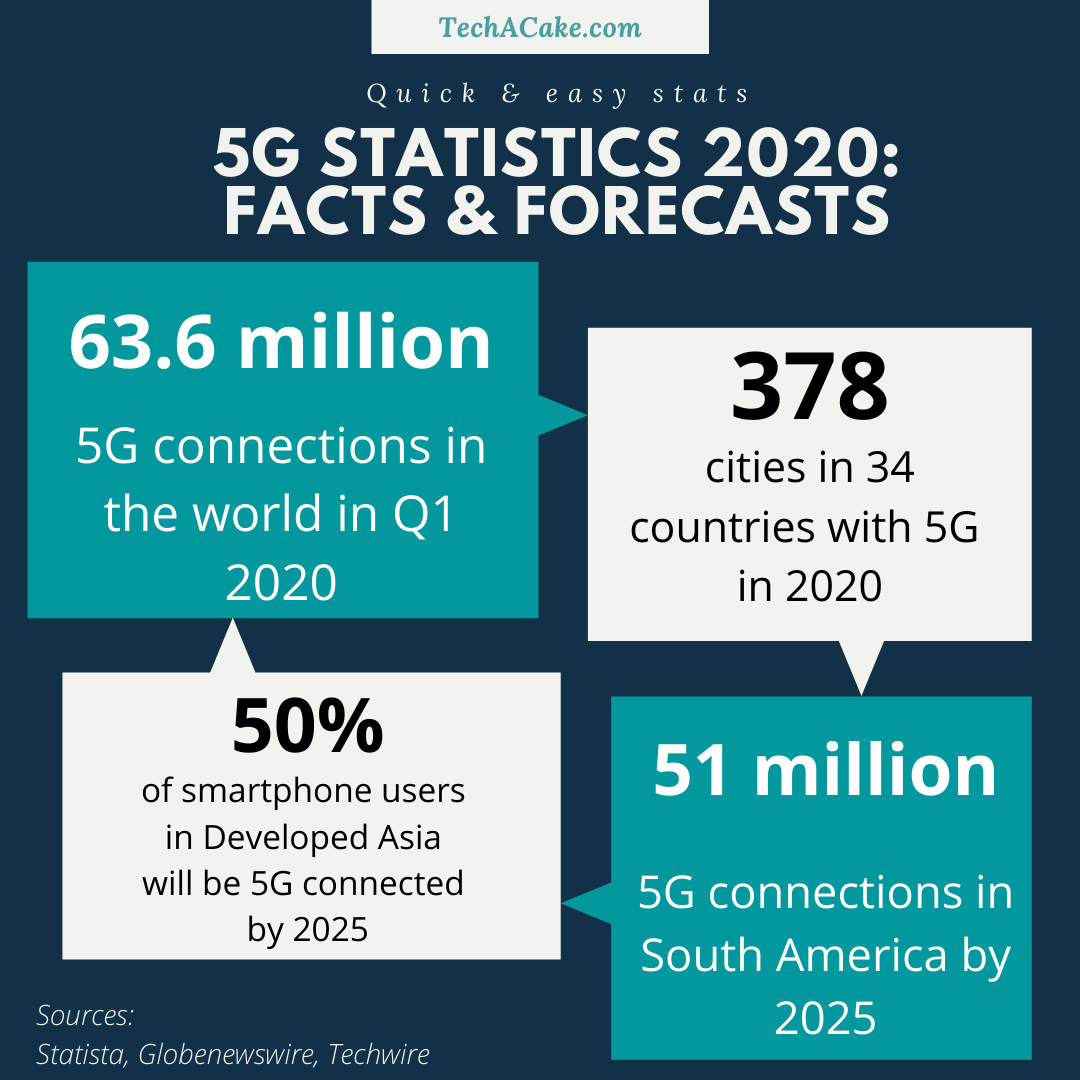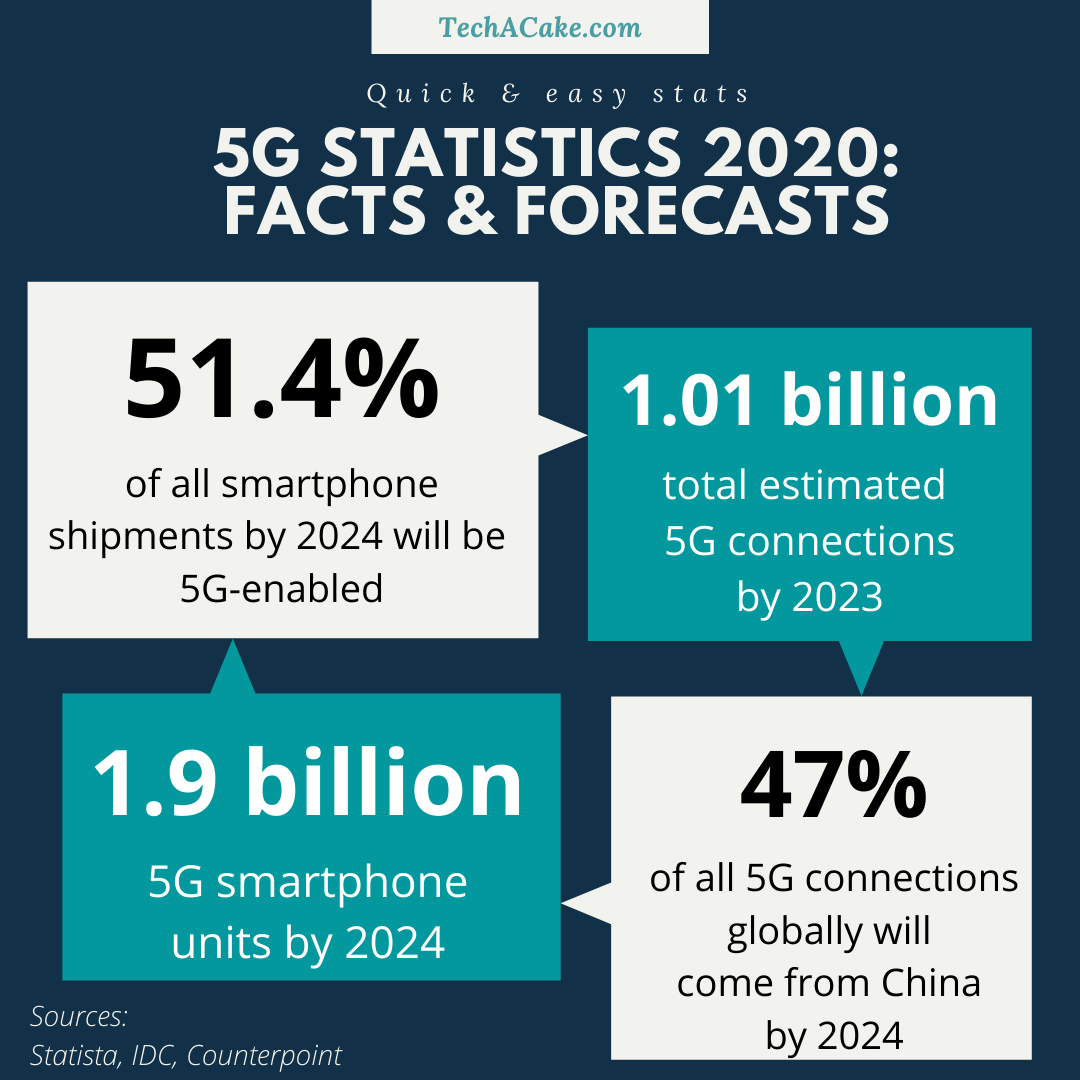
5G Statistics 2021: how many people use 5G?
Last updated: August 15, 2021
Mobile telecommunications went through many changes through the years. Each new generation of mobile networks is faster than the last one, better than the last one and more desired than the last one.
The 5G availability across the globe is limited and many people still use the good old 4G network. However, let’s have a look at the numbers and see how many are actually those who have peaked.
In this short article we’ll share with you:
- An extensive list of 5G statistics for 2020 and 2019.
- A list of 4G statistics 2020 to help us see things in perspective.
- A list of FAQs to satisfy your curiosity.
Today we’ll take a good look at 5G by the numbers. We gathered the latest statistics that will show us the state of affairs of 5G.
Enjoy our TechACake.com special!
5G statistics 2020
During the last Apple event which took place on October 13, 2020, when Tim Cook announced the newest iPhone 12, 5G implementation was the star of the show.
Because of the pandemic, the whole event was held in the Apple park to no audience. They streamed it online. During the event, the CEO of Verizon, one of the top 3 internet providers in the US, promised the incredible performance and the fastest download speed for the 5G iPhone with the 5G Ultra Wideband.

Image © Ars Technica / The updated map of Verizon's coverage in the US (October 2020).
Now, what is the 5G penetration in 2020? We start with the most important stats of 2020:
- In Q1 2020, there were 63.6 million total 5G connections in the world.
- 1.24 billion smartphones are expected to be produced in 2020 and 18.9% of all will be 5G compatible.
- In 2020, there are 3.5 million 5G IoT endpoints.
- In Q1 2020, there were already 378 cities in 34 countries in the world with a 5G network.
- In Q1 2020, Samsung accounted for 8.3 million global 5G smartphone shipments.
- In Q1 2020, Huawei accounted for 8 million global 5G smartphone shipments.
- In 2020, consumer electronics account for 22.6% of the total 5G infrastructure market.
- In July 2020, there were already 7 million 5G subscribers in South Korea.
- In 2020, the top 3 countries where users spend more than 20% of their mobile time on a 5G network, are Saudi Arabia, Kuwait and Hong Kong.
The world of mobile internet connectivity is constantly improving. The fifth generation cellular network offers significantly faster data speed to users across the globe. However, they say that it will take until 2035 to see how exactly 5G will have affected the global economy.

Now, we go back to last year and see how things go started:
5G statistics 2019
5G was launched in early 2019. How many people used 5G in 2019? How many smartphones supported 5G in 2019? You’ll find the answers below:
- In 2019, the number of 5G connections in the world was 10 million, six times less than in 2020.
- In 2019, there were 18.7 million total 5G smartphone shipments.
- In 2019, 0.9% of all the smartphones shipped last year were 5G-enabled smartphones.
- In 2019, Samsung accounted for 6.7million global 5G smartphone shipments.
- In 2019, Huawei accounted for 6.9 million global 5G smartphone shipments.
Next:
5G forecasts
What is the future of 5G? Is it going to replace 4G entirely? Here we go:
- By 2025, the estimated number of 5G users in Developed Asia is 50% of the smartphone users.
- By 2025, the number of total 5G mobile subscriptions is estimated to reach 2.7 billion.
- By 2025, the total number of 5G connections in South America is expected to reach 51 million.
- By 2025, 59% of South Korean subscribers, 50% of US subscribers and 49% of Japanese subscribers will use 5G.
- By 2014, 51.4% of the total smartphone shipments in the world will be 5G-enabled.
- By 2024, 1.9 billion smartphone users around the world will use the 5G network.
- By 2023, the total 5G connections in the world are predicted to reach 1.01 billion.
- By 2023, connected cars are predicted to be the largest 5G IoT endpoint market - they will account for 19 billion endpoints.
- By 2023, 8.9% of all mobile devices will use 5G connection.
- By 2024, the prognosis says China will make 47% of all 5G connections in the world.

It’s obvious that things look good for 5G in the future. Now, here are some bonus facts about 5G that you might find intriguing:
Bonus: 5G facts
- In 2020, the US, South Korea and China are the countries that use 5G the most.
- As of January 2020, 50 cities in the US gained access to the 5G network.
- The three major 5G providers in the US are verizon, AT&T and T-Mobile.
- On October 31, 2019, three of the major Chinese mobile operators launched the 1st in the world 5G mobile service.
- 5G frequency is about 28 GHz. In comparison, 4G enabled between 600 MHz and 2.5 GHz.
- In April 2020, the government of Japan took the decision to invest $14.4 billion in the next 5G for the purposes of adopting the 5G network.
There will be more and more 5G devices in the future. So, the next question we need to ask is:
How fast is 5G in 2020?
5G speed
What used to take minutes to download with a 4G connection takes only seconds with 5G. With the high-frequency airwaves of 5G the future feels closer, so to speak.
Is there a significant difference between the 5G vs 4G speed? Initially, they expected 5G to be between 10 and 100 times faster than 4G. However, in reality 5G has yet to reach its potential. Have a look:
- The maximum speed of 5G in 2020 reaches 1-10Gbps.
- In August 2020, the fastest overall average 5G downloading speed was registered in Saudi Arabia - 144.5 Mbps.
- The average 5G downloading speed is somewhere between 1.4x and 14.3x faster than 4G.
- The top speed of 4G real-world download speed is 100 Mbps. This is 30 times faster than 3G.
- In June 2020, the maximum download speed of Verizon 5G network in the US was 494.7 Mbps.
Now, let’s put things into perspective and see what 4G has to offer:
4G statistics 2020
The global state of mobile networks changed dramatically when 5G came on stage. However, it will take years for 5G to reach the majority of internet users in the world. For the time being, we can enjoy the now wide-spread 4G availability.
They say the 4G network is 10 times faster than the 3G. However, 3G is old news now. What we want to know is:
How many people still have access only to a 4G network in 2020?
- By 2025, the total coverage of 4G connections in Latin America is expected to be around 468 million.
- In 2019, 97.5% of South Koreans had access to a 4G network.
- In 2019, 95.9% of the mobile users of Verizon in the US had access to 4G coverage.
- In 2020, 88.8% of UK users have access to a 4G network.
Conclusion
It’s unlikely that 5G will fully replace 4G soon. However, it will lead to serious changes in the global economy and the overall quality of internet connection. Android users have enjoyed the perks of the 5G network all over the world since 2019. And in 2020, Apple’s iPhone 12 can access the 5G network for the first time. We’ll keep you updated for the latest 5G news. Stay tuned on TechACake.com.
FAQ
Where is 5G available in 2020?
Follow this 5G coverage map and you can track the availability of 5G networks on the globe. They also post the latest 5G news and updates. And if you zoom in on the map you can check whether there are 5G towers near you.
When is 6G coming?
2030. They are already working on it in China and 6G researchers and developers are at work as we speak. Once again, speed is what scientists are trying to enhance with the next generation mobile network. They say that coming up with a 6G network is crucial for humanity's tech progress. In 2020, China is still very busy with the massive deployment of 5G connections.
Which country is leading in 5G technology?
China. Followed by South Korea, the US - respectively the 2nd and 3rd 5G network countries. However, Switzerland deserves an honorable mention here - 5G in Switzerland is huge!
Does my smartphone support 5G?
Check out the list of ALL 5G compatible smartphones models and see whether yours is there. Do you need to buy a phone that supports 5G? It depends. If you live in an area where there’s no 5G network yet, you can wait until there is, and only then upgrade. If you have a local 5G network already, you should be aware that the new network will not render the current 4G connection you already have obsolete.
When and where was 5G first launched?
USA: On April 3, 2019 Verizon launched the first 5G network in the US.
South Korea: On April 3, 2019 (yes, same day), the first South Korean 5G network was launched by the three major providers in the country - SK Telecom Co., KT Corp. and LG Uplus Corp.
China: On November 1, 2019 China Mobile, China Telecom and China Unicom launched 5G services.
This is our report for the state of 5G in 2020. Hope that our selection of the latest 5G statistics was helpful.
Leave us a comment & follow us on Facebook!
See you on TechACake.com, guys!




